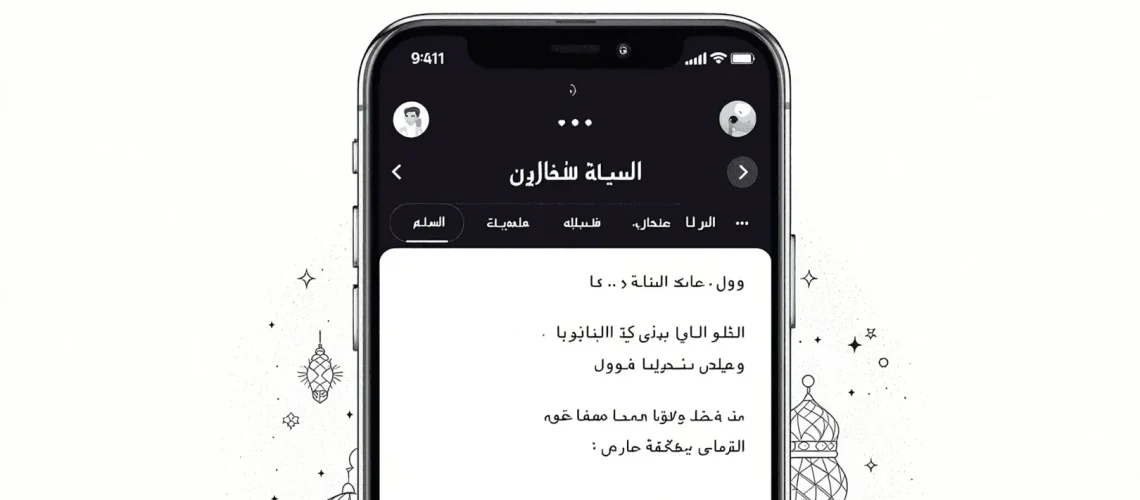The Arabic-speaking market represents a significant and rapidly growing user base of over 400 million people. This demographic shift has created an urgent need for digital interfaces that cater specifically to Arabic-speaking audiences, making Arabic interfaces a crucial skill for modern UX professionals.
The distinctive right-to-left reading direction of Arabic presents unique challenges that fundamentally reshape how users interact with digital interfaces. This natural reading pattern influences everything from navigation flow to content hierarchy, requiring a complete reimagining of traditional left-to-right design principles.
Creating effective Arabic interfaces demands more than simple text translation or layout mirroring. It requires a deep understanding of both technical requirements and cultural nuances. A successful Arabic interface seamlessly blends usability with cultural authenticity, creating experiences that feel natural and intuitive to Arabic-speaking users.
This guide explores essential principles and best practices for designing Arabic interfaces, helping you create digital experiences that resonate with Arabic-speaking audiences while maintaining the highest standards of user experience design.
Understanding Right-to-Left Layout Principles
The main difference between LTR and RTL layouts is how they guide reading and organize visual elements. While Western interfaces lead users from left to right, Arabic interfaces need to completely reverse this order. This mirroring affects every part of the interface design, including navigation menus and content placement.
Navigation Elements
Navigation elements require careful thought in RTL layouts. The primary navigation menu moves from the left side to the right side of the screen, with submenus expanding toward the left. Progress bars now move in a right-to-left direction, and directional icons must be flipped horizontally to stay consistent with Arabic reading patterns.
Key Interface Elements
The placement of important interface elements follows specific RTL principles. Call-to-action buttons should be positioned on the right side, where they naturally grab the user’s attention first. Content hierarchies flow from right to left, with primary information appearing on the right and secondary elements following to the left. This arrangement creates an intuitive visual path that aligns with Arabic users’ natural reading behavior.
Directional Indicators
Directional indicators need special care in RTL interfaces. Forward arrows point left while backward arrows point right—the opposite of their LTR counterparts. This applies to carousel controls, pagination arrows, and any other navigational elements that indicate movement or progression through content. Icons depicting timeline progression or step-by-step processes must also follow this right-to-left flow to maintain coherence with Arabic reading patterns.
Typography Considerations for Arabic Interfaces
Arabic script presents unique typographic challenges in digital interfaces due to its cursive nature and context-sensitive letter shapes. The inherent complexity of Arabic characters requires careful attention to font selection and implementation to maintain readability across different screen sizes and devices.
Characteristics of Arabic Script
- Cursive Nature: Arabic letters are connected in a flowing manner, which can affect how they are displayed in digital interfaces.
- Context-Sensitive Letter Shapes: The shape of an Arabic letter changes depending on its position within a word (initial, medial, final), making it crucial for fonts to accommodate these variations.
- Vertical Orientation: Unlike Latin scripts that primarily extend horizontally, Arabic script has vertical elements such as ascenders and descenders.
Challenges in Typography for Arabic Interfaces
- Font Selection: Choosing a font that supports the unique features of Arabic script is essential. Not all fonts are designed to handle the complexities of Arabic characters, so it’s important to opt for typefaces specifically created for this purpose.
- Line Spacing: Generous line spacing is necessary to prevent overlapping of characters due to their vertical nature. This is particularly important when displaying multiple lines of text or paragraphs.
- Responsive Design: With the increasing use of mobile devices and varying screen sizes, it’s crucial to ensure that the chosen font maintains legibility across different platforms. This may require testing the font on various devices and making adjustments accordingly.
Recommended Arabic Fonts for Digital Interfaces
Here are some recommended fonts that work well in digital interfaces:
- Cairo: A contemporary sans-serif typeface that excels in user interfaces, offering excellent legibility at various sizes and weights. Its balanced proportions make it ideal for headlines and body text.
- Tajawal: Known for its clean, modern aesthetic, Tajawal provides exceptional readability in both print and digital formats. Its simplified letterforms maintain cultural authenticity while optimizing screen display.
- Rubik: This versatile font family includes comprehensive Arabic support and works particularly well for multilingual interfaces where consistency between scripts is essential.
- Play: Suitable for creative applications and gaming interfaces, Play offers a modern interpretation of Arabic script while maintaining readability.
Form Field Design Considerations
When designing form fields that involve Arabic text input, there are several factors to keep in mind:
- Horizontal Space Requirements: Names and addresses written in Arabic often require more horizontal space compared to their Latin equivalents. It’s important to account for this difference when designing input fields.
- Responsive Input Fields: Implementing responsive input fields that automatically adjust their width based on the length of the content can help accommodate variations in text length across different languages.
- Character Count Indicators: Adding character count indicators next to input fields can provide users with visual feedback on how many characters they have entered or how many are remaining. This can be especially useful when there are limits on the number of characters allowed.
- Expandable Text Areas: For longer pieces of text, such as comments or messages, consider using expandable text areas that allow users to see more content without scrolling excessively.
Diacritical Marks (Tashkeel) Considerations
Diacritical marks (tashkeel) play an important role in accurately representing certain sounds and meanings in Arabic words. When designing interfaces that display Arabic text with tashkeel:
- Adequate Vertical Space: Ensure there is enough vertical space allocated for these marks so that they don’t overlap with other elements or become difficult to read.
- Proper Font Rendering: Test how different fonts render tashkeel marks at various sizes and weights to ensure they maintain their intended positioning.
By considering these typography considerations specific to Arabic interfaces, designers can create more inclusive experiences that cater to diverse users while maintaining visual appeal and usability across digital platforms.
Incorporating Cultural Relevance into UI Design
Cultural sensitivity is crucial for successful Arabic interface design. Understanding Arab cultural values, traditions, and aesthetics can make the difference between an interface that resonates with users and one that alienates them. Ignoring cultural considerations risks creating designs that feel foreign, inappropriate, or even offensive to Arab users.
Finding the Right Balance with Cultural Elements
When integrating cultural elements into UI design, it’s important to strike a delicate balance. Traditional Arabic geometric patterns and Islamic art motifs can enhance visual appeal when used subtly in backgrounds, borders, or decorative elements. These design elements should complement rather than compete with the interface’s primary functions.
The Importance of Color Selection in Arabic UI Design
Color selection plays a vital role in Arabic UI design. Here are some key colors and their meanings in Arab culture:
- Green holds special significance in Arab culture, representing life, growth, and spiritual connection.
- Gold signifies luxury and prosperity, making it suitable for premium features or important calls-to-action.
- Deep blues and turquoise evoke feelings of protection and spirituality, ideal for trust-building elements like security badges or privacy settings.
Respecting Local Cultural Norms through Visual Hierarchy
The visual hierarchy should respect local cultural norms. Consider the following when designing:
- Images of people should align with modest dress codes.
- Certain symbols or gestures may carry different meanings across Arab regions.
Creating Authentic Connections through Photography
Photography featuring local architecture, landscapes, and daily life scenarios helps create authentic connections with users. Showcase images that reflect the culture and experiences of your target audience.
Incorporating Familiar Cultural References in UI Elements
UI elements like icons and illustrations should incorporate familiar cultural references while maintaining modern design standards. This ensures that your design speaks to the cultural identity of your users without compromising on usability or contemporary aesthetics.
Language Adaptation and Content Localization
Successful Arabic interface design demands more than simple word-for-word translation. Machine translation tools often miss cultural nuances and contextual meanings crucial for effective communication. Professional linguists who understand both languages’ intricacies create translations that resonate authentically with Arabic-speaking users.
Challenges in Arabic UX Design
There are several challenges that designers face when creating user experiences for Arabic-speaking audiences:
- Text Expansion: Arabic text typically requires 25-40% more space than its English counterpart. This expansion affects button sizes, menu layouts, and overall interface spacing.
- Regional Dialect Variations: A word commonly used in Saudi Arabia might carry different connotations in Morocco or Egypt.
- Numerical and Date Formats: Arabic interfaces should display numbers in Eastern Arabic numerals (٠, ١, ٢) when appropriate, and calendar formats must account for both Gregorian and Hijri dates.
- Cultural Adaptation: Successful localization extends beyond literal translation to include adapting idiomatic expressions and metaphors that make sense in Arabic culture.
Solutions for Effective Arabic UX Design
To overcome these challenges, designers can implement the following solutions:
- Flexible Containers: Use flexible containers that can expand or contract based on the length of the text.
- Responsive Layouts: Create responsive layouts that adjust to different screen sizes and orientations.
- Professional Translators: Work with professional translators who are familiar with regional dialect variations to ensure accurate communication.
- Right-to-Left Alignment: Maintain right-to-left alignment for phone number fields and other relevant elements.
By understanding these challenges and implementing effective solutions, designers can create user experiences that are tailored to the needs of Arabic-speaking audiences. This Arabic localization not only enhances user experience but also opens up new opportunities for global brands in the Arab market.
Conclusion
Creating effective Arabic interfaces requires a comprehensive approach that combines RTL layout principles with cultural considerations. The successful use of RTL design patterns and carefully chosen Arabic typography forms the foundation of user-friendly Arabic digital experiences. These technical elements work together with culturally relevant design choices to create interfaces that truly resonate with Arabic-speaking users.
The journey toward excellence in Arabic interface design involves continuous improvement through testing with native speakers and local UX experts. This iterative process helps identify subtle details that automated tools might overlook, ensuring both functional accuracy and cultural authenticity. By staying committed to testing and adaptation, designers can create digital experiences that feel natural and intuitive to Arabic users.
Designing for Arabic interfaces presents an opportunity to bridge cultural gaps while providing exceptional user experiences. Collaborating with a Best Web Design company in Dubai or a reliable Website development company in Dubai ensures that technical expertise and cultural insights are combined effectively. When done correctly, RTL UX design goes beyond technical implementation and becomes a powerful tool for connecting with Arabic-speaking audiences in meaningful ways.





